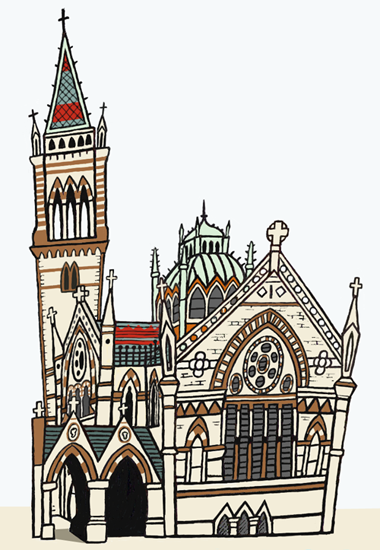RICHARD S. DARGAN | Architecture
New Old South Church, Boston | |||||||
|
|
Date: 1875 Architect: Charles Amos Cummings and Willard T. Sears New Old South provides a soaring Gothic counterpoint to Trinity Church, H.H. Richardson's squat Romanesque masterpiece on the opposite corner of Copley Square. The church's unusual name owes itself to a peripatetic congregation that landed here in the 1870s after a stretch at the Old South Meeting House. In designing New Old South, architects Cummings and Sears took inspiration from the ecclesiastical buildings of northern Italy. The church's copper lantern is reminiscent of the cupolas of St. Mark's in Venice, and the campanile recalls the cathedral bell tower in Siena. The exterior has a riot of detail, with stone inlay and tracery, Moorish and zebra-striped arches, ironwork and a polychromatic roof of red and black slate tiles. At 246 feet, the original tower of New Old South was considerably taller than the current incarnation, but Back Bay's landfill was ill-suited for such as a heavy load; the campanile started to lean and had to be replaced in the 1930s. Cummings and Sears favored the Italian Gothic revival that spread from Europe to America in the mid-1800s as a kind of reaction against order and mechanization. The movement found its voice in British art critic John Ruskin and his books, The Seven Lamps of Architecture (1849) and The Stones of Venice (three volumes, 1851-1853). When comparing Gothic to Renaissance architecture, Ruskin wrote: "The Gothic spirit not only dared, but delighted in, the infringement of every servile principle; and invented a series of forms of which the merit was, not merely that they were new, but that they were capable of perpetual novelty. The pointed arch was not merely a bold variation from the round, but it admitted of millions of variations in itself; for the proportions of a pointed arch are changeable to infinity, while a circular arch is always the same." Cummings' own travels in Italy no doubt helped inspire New Old South and some of his other work with Sears, including the freestanding campanile of the Pilgrim Monument in Plymouth, Mass. |
||||||
